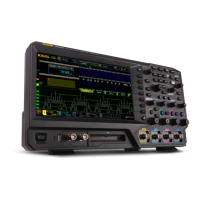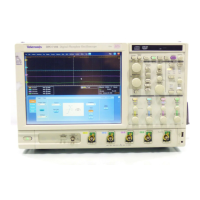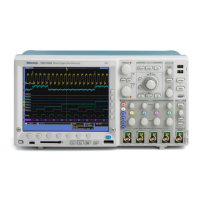Status and Events
Serial Poll Met
hod: Enable the OPC bit in the Device Event Status Enable
Register (DESER) and the Event Status Enable Register (ESER) using the DESE
and *ESE commands.
When the operation is complete, the O PC bit in the Standard Event Status Register
(SESR) will be enabled and the Event Status Bit (ESB) in the Status Byte Register
will be enabled.
The same command sequence using the *OPC command for synchronization with
serial polling looks like this:
/** Set s up condit ional acquisition **/
ACQUIRE:STATE OFF
SELECT:CH1 ON
HORIZONTAL:RECORDLENGTH 500
ACQUIRE:MODE SAMPLE
ACQUIRE:STOPAFTER COUNT 1
ACQUIRE:STOPAFTER:MODE CONDITION
/** Ena ble the sta tus registers **/
DESE 1
*ESE 1
*SRE 0
/** Set s up the data preamble **/
DATA:START 1
DATA:STOP 500
DATA:ENCDG RIBINARY
/** Cle ar data and then acquir e waveforms until
conditional stop occur s**/
ACQUIRE:DATA:CLEAR
ACQUIRE:STATE ON
/** Wai t until the acquisition is complete before
querying the curve data**/
*OPC
While s erial poll = 0, k eep looping
/** Get the curve data **/
CURVE?
This technique requires less bus traffic than did looping on BUSY.
Service Request Method: Enable the OPC bit in the Device Event Status Enable
Register (DESER) and the Event Status Enable Register (ESER) using the DESE
and *ESE commands.
You can also enable service requests by setting the ESB bit in the Service Request
Enable Register (SRER) using the *SRE command. When the operation is
complete, a Service Request will be generated.
The same command sequence using the *OPC command for synchronization
looks like this:
/** Set s up condit ional acquisition **/
DSA/CSA/TDS8X00/B Series Programmer Manual 3-9

